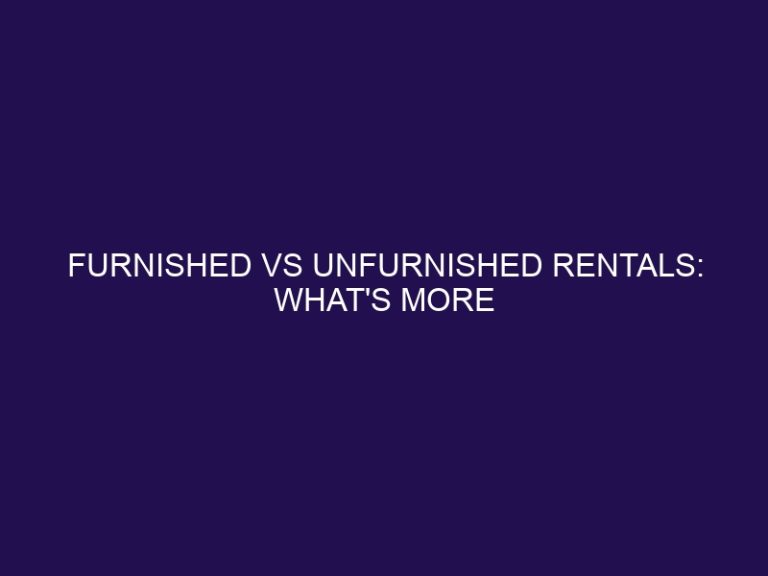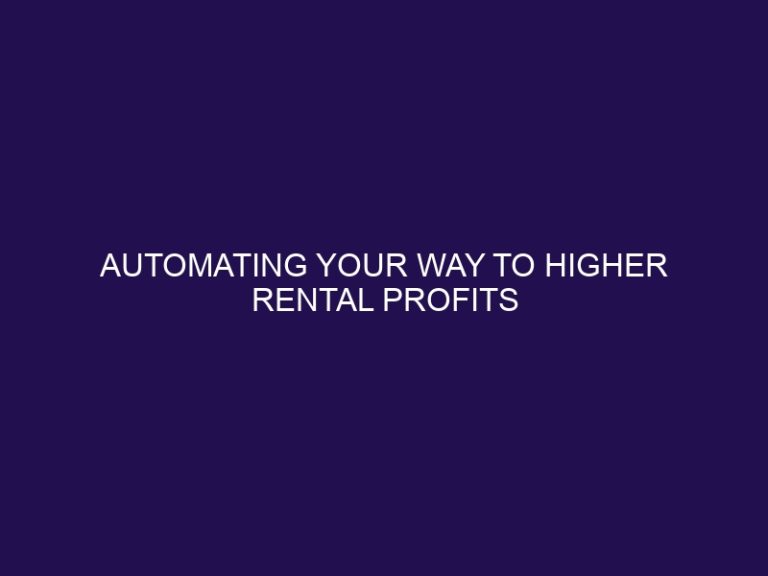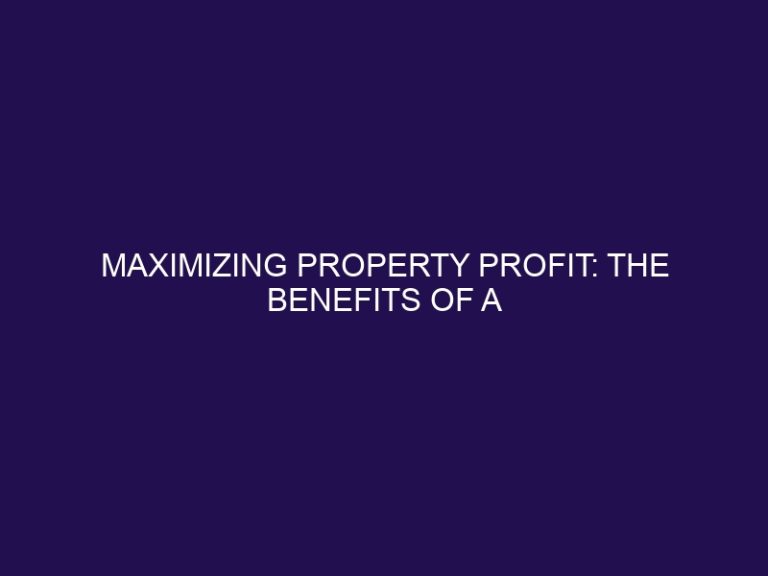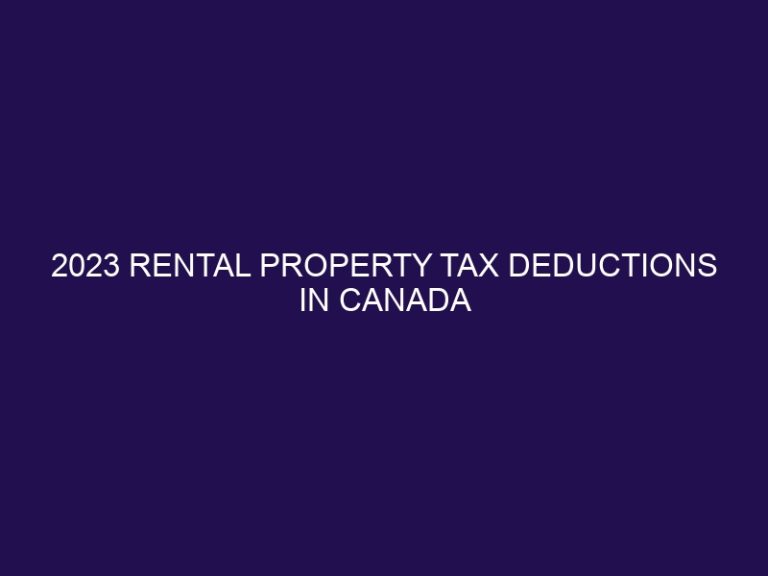Short-Term vs Long-Term Rental Pricing: What Works Best?
When it comes to renting out a property, one of the biggest decisions property owners face is whether to offer short-term or long-term rental options. Short-term rental pricing refers to renting out a property for a short period, typically less than six months, while long-term rental pricing involves offering a property for a longer period, usually a year or more. The decision between these two options can significantly impact the profitability of a rental property, making it crucial for property owners to carefully consider their pricing strategy.
There are several factors to consider when setting rental pricing, such as location, demand, amenities, and seasonality. These factors can play a significant role in determining the success of a rental property, as they affect both the occupancy rate and rental income. Additionally, there are several key differences between short-term and long-term rental pricing that property owners should be aware of.
One of the main differences between the two pricing models is the rental duration. Short-term rentals are typically shorter in duration, allowing for more flexibility and potential for higher occupancy rates. On the other hand, long-term rentals offer more stability and reliable income, making it a suitable option for property owners looking for a steady stream of income.
The type of property also plays a role in determining which pricing model is best. For vacation homes, short-term rental pricing would likely be more profitable due to the high demand for short stays. In contrast, urban apartments may benefit more from long-term rental pricing, as there is a constant demand for long-term housing in cities. Suburban houses can benefit from either pricing model, depending on the target market and location.
Both short-term and long-term rental pricing have their pros and cons. Short-term rental pricing allows for more flexibility and potential for higher income, but it also requires more effort and maintenance. Long-term rental pricing offers more stability and less maintenance but may result in lower income. Ultimately, the best pricing model may vary based on individual circumstances and goals.
In the long run, long-term rental pricing may be more profitable due to the steady income and lower expenses. However, property owners can maximize their rental income by offering discounts for longer stays, utilizing dynamic pricing strategies, and continuously monitoring the market for changes in demand and competition. By carefully considering all these factors, property owners can make an informed decision on which rental pricing model works best for their property.
What Is Short-Term Rental Pricing?
What Is Short-Term Rental Pricing? Short-term rental pricing refers to the cost of renting a property for a brief period, typically less than six months. These rates are often higher than long-term rates due to the increased turnover and maintenance costs associated with short-term rentals. When determining competitive short-term prices, it is important to consider factors such as demand, location, and amenities.
What Is Long-Term Rental Pricing?
Long-term rental pricing, also known as extended rental pricing, is the amount charged for renting a property for a duration of 12 months or longer. This type of rental typically offers lower rates than short-term rentals, providing stability for both landlords and tenants. It also allows tenants to better budget their expenses.
What Are The Factors To Consider When Setting Rental Pricing?
When it comes to setting rental pricing, there are several key factors that must be taken into consideration. These factors can greatly impact the success and profitability of a rental property. In this section, we will discuss the various elements that should be considered when determining the rental pricing for a property. From the location and demand of the rental market to the amenities offered and seasonal fluctuations, each factor plays a crucial role in finding the optimal rental pricing strategy.
1. Location
- Research the demand and growth potential of the location.
- Assess the safety and amenities of the neighborhood.
- Evaluate the proximity to attractions and transport links in the area.
- Analyze any local regulations that may impact short-term rental operations.
2. Demand
- Assess local demand trends to determine peak rental periods.
- Analyze historical booking data to identify high-demand periods and adjust pricing accordingly.
- Monitor fluctuations in market demand to adapt rental rates for optimal occupancy and revenue.
3. Amenities
- Take into consideration the amenities provided by the rental property, including swimming pools, gyms, parking facilities, and laundry services.
- Make sure that the amenities meet the needs and preferences of the target renters, adding to the overall attractiveness of the property.
- Regularly upkeep and upgrade the amenities to maintain their quality and usefulness, leading to tenant satisfaction and favorable reviews.
4. Seasonality
Seasonality greatly affects the pricing of short-term rentals. For example, popular vacation destinations often have a high demand during the summer, resulting in higher rates. On the other hand, off-peak seasons may require lower rates to attract guests. Therefore, it is important to understand the impact of seasonality on rental income in order to optimize profits.
What Are The Differences Between Short-Term And Long-Term Rental Pricing?
When it comes to renting out a property, there are two main pricing options: short-term and long-term. Each option offers its own set of advantages and challenges. In this section, we will discuss the key differences between short-term and long-term rental pricing. From the duration of the rental to the stability of income, we will cover the various factors that can impact your decision on which pricing strategy works best for you. So let’s dive into the differences and see which option aligns better with your goals.
1. Rental Duration
- Understand the intended rental duration for your property.
- Evaluate short-term vs. long-term prospects based on the desired rental duration.
- Consider the impact of rental duration on income stability and occupancy rates.
- Assess the level of flexibility required for managing different rental durations.
When determining the optimal rental duration, property owners should carefully analyze their market, property type, and financial goals to make informed decisions.
2. Flexibility
- Allow for short-notice bookings to attract spontaneous travelers.
- Set flexible cancellation policies to accommodate changing guest plans.
- Offer different check-in and check-out times for guest convenience.
Pro-tip: Flexibility can increase bookings, but clear boundaries are essential for smooth operations.
3. Occupancy Rates
- Monitor demand trends to adjust pricing based on peak and off-peak periods and maintain high occupancy rates.
- Offer incentives for longer occupancy to ensure consistent income and occupancy rates.
- Consider flexible cancellation policies to attract more guests and improve occupancy rates.
- Regularly update pricing based on market analysis and competition to maximize occupancy rates.
Pro-tip: Analyzing local events and seasonal attractions can help optimize occupancy rates and pricing strategy, leading to higher occupancy rates.
4. Income Stability
- To ensure income stability, property owners should consider signing long-term lease agreements.
- Regular property maintenance is also important in retaining tenants and maintaining a stable rental income.
- Diversifying property investments can also help mitigate financial risks.
By diversifying investments, maintaining properties, and securing long-term lease agreements, property owners can enhance their income stability.
Which Pricing Model Is Best For Different Types Of Properties?
As a property owner, determining the best pricing strategy for your rental can be a daunting task. Should you opt for short-term or long-term rentals? The answer may depend on the type of property you have. In this section, we will discuss the ideal pricing model for different types of properties, including vacation homes, urban apartments, and suburban houses. By understanding the unique features and target market of each type, we can determine which pricing approach will yield the most success.
Vacation Homes
Short-term rental pricing offers many benefits for vacation homes, including higher nightly rates and flexibility for owners to use the property. However, these properties also face challenges such as seasonal demand fluctuations and the constant need for property management. A friend’s beach house rental experienced a 30% increase in income after implementing adjusted pricing strategies.
Urban Apartments
Urban apartments necessitate the use of dynamic pricing to accommodate fluctuations in demand. When determining competitive rates, take into consideration the location, nearby amenities, and local events. While the potential for higher income is a pro, the cons include a higher turnover rate.
To maximize income, consider offering discounts for longer stays and consistently maintain the appeal of the property.
Suburban Houses
Suburban houses are a great option for short-term rentals, providing a peaceful retreat from the hustle and bustle of city life. Families and travelers looking for a quiet environment will be attracted to these properties. Consider offering amenities such as spacious gardens, outdoor seating areas, and proximity to local attractions to make your rental stand out.
On the other hand, long-term rental pricing for suburban houses guarantees a steady income, especially from reliable tenants. Highlight features like highly-rated school districts, community facilities, and nearby transportation options to attract long-term renters.
What Are The Pros And Cons Of Short-Term Rental Pricing?
As a property owner, deciding on the pricing strategy for your rental can be a daunting task. One option is to offer short-term rentals, which allow for flexibility and higher profits, but also come with their own set of pros and cons. In this section, we will discuss the potential advantages and disadvantages of short-term rental pricing, so you can determine if this approach is the right fit for your property. From increased income to potential risks, we’ll cover it all.
1. Pros
- Potential for higher income
- Flexibility to use property when unoccupied
- Ability to adjust pricing based on demand
Consider the flexibility and income potential when weighing the pros and cons of short-term rental pricing.
2. Cons
- Potential vacancy: Long-term rentals may experience longer periods of vacancy between tenants, impacting income stability.
- Reduced flexibility: Long-term leases limit the owner’s flexibility to use or access the property.
- Cons: Long-term rental pricing may not adjust quickly to market fluctuations, affecting potential income.
What Are The Pros And Cons Of Long-Term Rental Pricing?
When it comes to rental pricing, there are two main strategies: short-term and long-term. While short-term rentals may bring in immediate profits, long-term rentals offer stability and potential for higher returns in the long run. In this section, we will delve into the pros and cons of long-term rental pricing. From increased financial security to potential maintenance costs, we will examine both the advantages and disadvantages of this rental strategy.
1. Pros
- Higher Income Potential: Short-term rentals generally yield higher income due to higher nightly rates and potential for increased occupancy.
- Flexibility: Property owners have the flexibility to use the property themselves or make it available for friends and family.
- Property Maintenance: Regular cleanings for short-term rentals can help maintain the property and address any issues promptly.
2. Cons
Long-term rental pricing cons may include:
- Lower income potential due to fixed rates.
- Limited flexibility for property use.
- Extended vacancies between tenants.
However, historical data indicates that long-term rentals offer stable, consistent income streams for property owners.
Which Pricing Model Is More Profitable In The Long Run?
In the long run, the long-term rental pricing model proves to be more profitable. It guarantees a consistent income stream, lowers turnover expenses, and minimizes vacancy periods, ultimately leading to sustained profitability over time.
How Can Property Owners Maximize Their Rental Income?
As a property owner, one of your main goals is to maximize your rental income. A crucial aspect of this is determining the most effective pricing strategy for your rental property. In this section, we will explore the concept of short-term versus long-term rental pricing and how it can impact your income. Specifically, we will discuss the potential benefits of offering discounts for longer stays and how this can attract more guests and ultimately increase your earnings.
1. Offer Discounts For Longer Stays
- In order to incentivize longer stays, consider offering discounted weekly or monthly rates.
- For extended bookings, provide additional perks such as complimentary housekeeping or access to facilities.
- To encourage recurring long-term guests, implement a loyalty program that offers future discounts or benefits.
Frequently Asked Questions
What is the difference between short-term and long-term rentals?
Short-term rentals are properties rented for 90 days or less, while long-term rentals have tenants on leases of six months or longer.
What are some key takeaways when considering short-term vs long-term rental properties?
Both types of rentals have their own advantages and drawbacks, and the decision to invest in one over the other depends on an individual’s comfort level and expectations.
Long-term rentals generally require less management and offer consistent income, while short-term rentals may have higher potential for rental income but come with higher management fees and tenant turnover.
What are the benefits of investing in short-term vacation rentals?
Short-term rentals offer flexibility and control for owners, as they can use the property for personal vacations and block off dates for themselves.
They also tend to have less wear and tear and easier maintenance, as they are occupied less frequently and cleaned more regularly.
What are the benefits of investing in long-term vacation rentals?
Long-term rentals offer stability and consistent income for investors, as tenants typically stay for longer periods of time.
They also have lower turnover and less competition, as there are fewer properties available for long term stays.
What factors should I consider when deciding between short-term and long-term rentals?
The decision to position a property as short-term or long-term depends on the market and personal preference of the investor.
Additional factors to consider include the property’s location, market conditions, and local laws and regulations.
What are some of the risks associated with short-term rentals?
Short-term rentals may have higher turnover, more competition, and the need for constant advertising to keep the property occupied.
They may also come with higher management fees and potential for maintenance problems if the wrong tenant is chosen.







